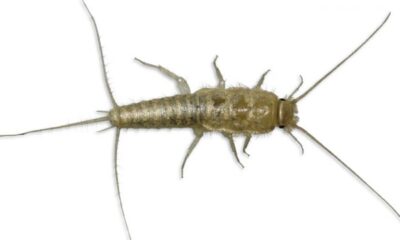HOW TO IDENTIFY IF YOU HAVE A SILVERFISH PROBLEM? Silverfish can ruin papers, clothing, and wallpaper.
 Silverfish are mostly nocturnal and prefer to feed at night
Silverfish are mostly nocturnal and prefer to feed at night
 Silverfish are sometimes cannibals, feeding on other dead or wounded silverfish
Silverfish are sometimes cannibals, feeding on other dead or wounded silverfish
 Silverfish are fast runners but are not able to climb walls as fast
Silverfish are fast runners but are not able to climb walls as fast
 The presence of silverfish in a home is usually a sign that there is water damage
The presence of silverfish in a home is usually a sign that there is water damage

SILVERFISH CONTROL
SILVERFISH IDENTIFICATION
This insect grows to be about ¾ of an inch long and ranges from silver to brown in color. It has six legs, two antennae, and three body parts. Much like a fish, its width tapers from its head to the tip of its abdomen, which is adorned with two long cerci and one terminal filament. Silverfish also move a little like a fish, wiggling as they quickly disappear into hiding places.
ARE SILVERFISH DANGEROUS?
These tiny silver bugs are gross, but they are not known to present a health threat when they enter homes. They don’t bite or carry venom and they are not linked to the spread of human pathogens. If an infestation gets large enough, it may be possible for harmful bacteria to be spread from trash cans to food prep surfaces, but this is rare. Silverfish are not generally a kitchen pest. They prefer to live in moist basements, crawl spaces, and bathrooms.
ARE SILVERFISH DESTRUCTIVE?
Silverfish love glue and, since glue can be found in wallpaper, clothing, book bindings, book pages, and a wide range of other products we have in our homes, silverfish can be quite destructive. If you have valuable clothes or books, it is important to store them in plastic containers to protect them from silverfish.
